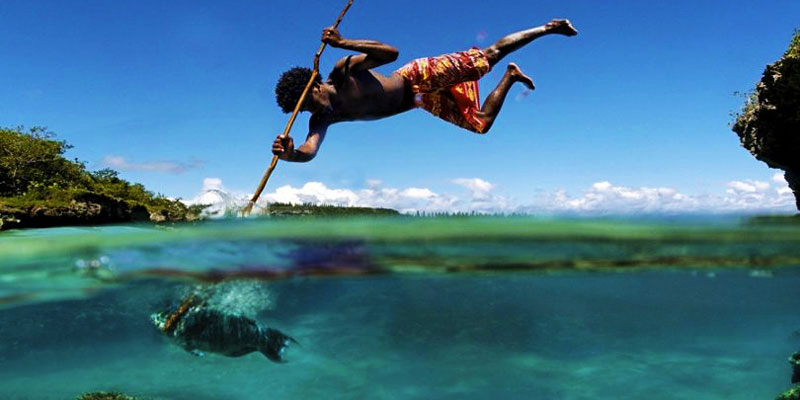When it comes to survival, the primary skills needed for living off the grid are finding food and shelter. In the moments of disaster, the water nurtures the most natural source of proteins — the fish. Survival fishing with right techniques just might increase your chances of keeping yourself and your family alive.
The reason why it is the first option is that the human body spends less energy angling than it does while hunting. Throughout history, our ancestors were turning to rivers and oceans in search of food. In a survival situation, it is much the same; the fish provides energy for extended periods of time. It is no wonder that you may come across a bear hunting in the same stream as yourself. Nature is a vast grocery store open for anyone, including wildlife.
Angling Throughout the History
Since the beginning of civilization, humans were hunting and fishing. The Incas were one of the first civilizations whose everyday diet contained fish. Being a part of the Andean region, seafood was a rare delicacy; however, the freshwater fish was a part of a daily meal. The villagers would use reed baskets in shallow waters hoping to catch the days lunch.
Ancient Egyptian empire spreading along the Mediterranean and Red sea, as well as the emerald Nile, was abundant in fish. The ancient Egyptians were skilled spear fishermen; the way of feeding the family later transformed into the sport for the upper classes. They were the first to consider angling with a hook and thin hand lines as a hobby and leisure for the pharaohs.
The tranquility of the Egyptians was found among the jungle natives of Thailand and Asia. The Asians had a distinct technique while fishing barehanded in the shallow freshwater. They would scrape bark from a naval tree, and roll it into leaves making a package, then toss the bait into shallow water and wait. The curious fish would come near the leaf and become dazed from the juices seeping from the bark. It was easy for the natives to catch them in such a state.
The Tools of Primitive Survivor
Unless you are fishing regularly, chances are that you are not going to have anything from the equipment. The necessary fishing tools are not hard to make, and you can use any material. The essentials in modern-day equipment are:
- Fishing rods,
- Lines,
- Hooks of various sizes,
- Baits,
- Containers for bait (live worms and insects)
- A cup for minnow,
- A knife for cutting the rope,
- A bucket for your catch.
In dire need for survival, you probably need the basics. Looking back at the ancient fisherman, they mostly made their gear. In the post-war countries, during the ’50s, people living on nearby riverbanks used to fish with a hook and line. Although the Tom Sawyer style has its merits, some skills — like anglers’ tranquility — are required for successful fishing.
Much like Sawyer, people still attach the line to a tree near the river. The tree allows the person to cast several lines with bait into the river, which comes in handy when trying to catch a lot of fish. The angler just needs to sit on the bank and wait patiently for the fish to bite.
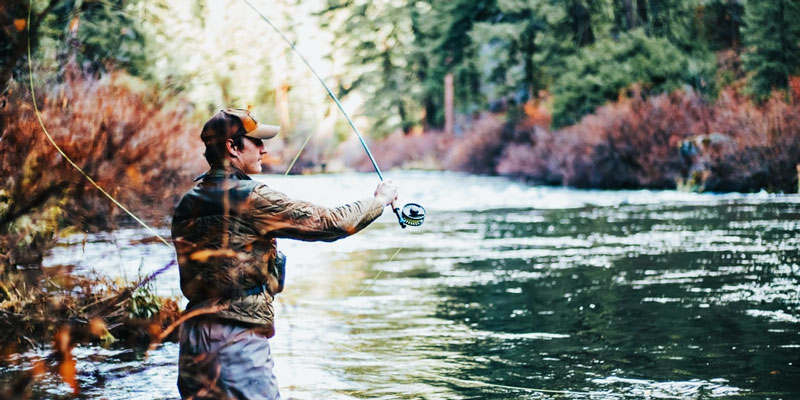
However, making a rod is not that complicated, and you can make it from the bones if you are lucky, or even a tree branch in the vicinity. The trick is to choose the greener branch since the old ones can snap easily when the fish starts to pull. All you need to do is tie down the line on top of the branch, and you have a primitive fishing rod.
The nets are illegal in most of the countries, but in case of dire need to catch a vast amount of fish the nets are the easiest way. The nets are still handmade in various parts of the world, and it is a craft of sorts. When you watch a Greek fisherman making a net with his scraped hands at the port, it is almost poetic. Rope nets are tied from several strings, crisscrossing them and tying down the knots.
The baskets made from birch have a similar effect. Much in the same manner the branches are intertwined at the top and tied together horizontally. However, tying them together requires a lot of strength to twist the branches. These baskets are traps, the bait is inside them, and when fish enters the basket, it is easy to catch it.
Trapping the fish has its advantages, by making a more massive trap there is a good chance of catching more than one. Having a camp nearby helps wait for the bite. Building a dam of sorts where you can make an enclosure out of tree trunks, makes it easier to trap the bass for example. Gathering tree trunks can be hard work, so choose the lighter ones, you don’t want to spend too much energy. Make an enclosure from four sides, but keep the fourth available for opening and closing; this is the one turned to the deeper waters.
Modern Day Fishing Techniques
Contemporary techniques draw their inspiration from history. Variety of civilizations made their tribute to angling, which is visible today. The modern-day anglers use various methods while out on the water. Depending on skills, some are more successful than others; either way they roll their sleeves and prepare to meet the underwater opponent.
Fly Fishing
Since ancient times, people would lure the fish with bait. The technique is fun but requires a lot of patience and a light bait. The method is commonly used for freshwater fish like salmon, trout, and bass. The rod has a long line with a lure on end, the most common way of fly fishing is to step in the river, cast the bait and simply wait.
Hand Fishing
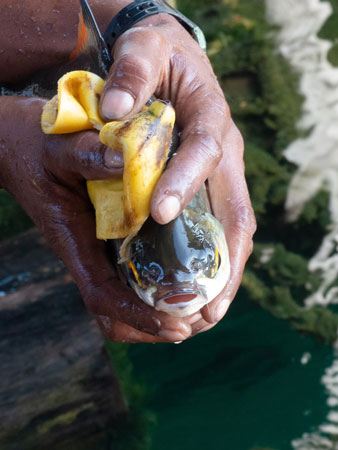
This technique requires an observant eye and determination. The very primitive way of catching fish with bare hands includes the knowledge to pull out the slippery opponent from the water. Pressing the fish too hard will cause her to panic and even give you several tail slaps. However, if you decide to go bare hand fishing, make sure to carry a bucket or something else to prevent the catch from slipping from your hands. Without applying pressure and holding it gently, try and pull it out on the surface.
Gillnetting
The methods are usually used in commercial purposes as the net can catch more than enough fish for several families. The net is cast across the streams and open waters, the fish enters the net and stays trapped. For decades it was the way to catch salmon and swordfish. Nets are connected with lines that hang vertically in the water, regularly spaced with floaters.
Spearfishing
Since the ancient times, people would use a spear to catch fish, in its primitive form it’s still used in some parts of the world. The modern version of spearfishing includes catching fish while scuba diving and snorkeling. The development of speargun and bottles of oxygen allow the diver to catch fish in deeper waters. 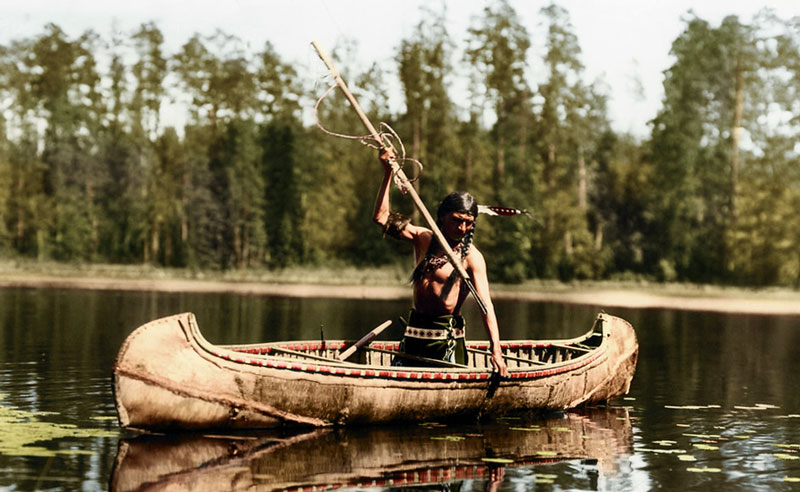
Natural Poison
Although not as ethical as other methods, the technique dates from the ancient civilizations when several men were obligated to catch fish for an entire village. Living off the grid, this method allows you to catch fish in shallow waters, otherwise, the flowing water would neutralize the natural poison. One of the options is to use young walnuts, by placing the husks in the water. The same technique can be applied to burnt seashells. Crushing them into powder and placing it on the surface has the same effect. Curious fish approaches the bait and you get a great amount of fish in a short time.

Trotline Fishing
A trotline is one long cord with several vertical lines with hooks on the end of each. There are weights keeping the cord in the same place at a regular distance. Much like the gill net, it is designed to catch more fish at once. The more you spread it the bigger the chance to make a rich catch.
Know Your Target and Environment
Whether you are at a lake, a river or open sea, not all places are rich in fish. In the survival mode feeding your family and yourself is of utmost importance. Therefore, you have to know what you are looking for, many species are congregating during the specific months, and in early mornings. Others may swim freely in the open waters in the afternoon. Different fish have distinct behaviors and find refuge in many places.
Choosing the right spot allows you to have a great catch without spending too much energy. Using their behavior as your advantage not only saves time, but also keeps you from dispersing a lot of unnecessary energy. Some of the most common fish like salmon, bass, and walleye, usually hide in the locations near the shore. Observe the environment and if you catch a glimpse of lily pads, grass or weeds growing along the water edge, most likely that is the place to cast your hook.
The problem with the grass in the ponds and lakes is that the hook often gets tangled in the debris. The trick is to lower the hook vertically, and on the first sign of pulling, lift the rod. One of many ways to trick the bass hiding in overgrowth is to place the line with a hook on the tree branch above the spot. You can place as many as you like, and the fish will never notice you are there.
The trouble is when the bass starts pulling away from the shore, and the fuss of cutting the hook lose makes a good amount of energy loss. The hooks tangled in the water, are often the reason why anglers choose to move and catch the trout swimming in the stream in the open seas.
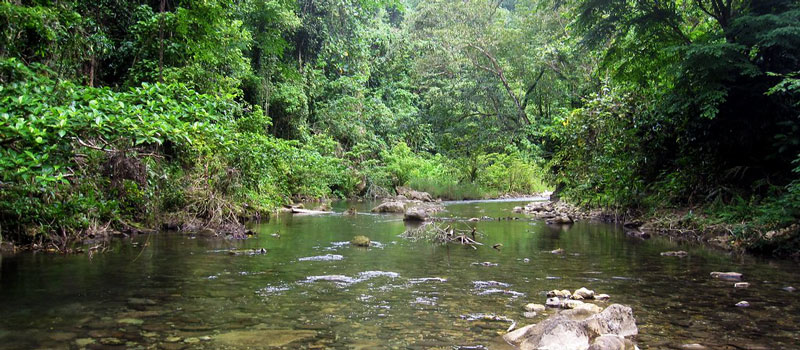
The weather conditions and time of the year can greatly impact the catch. The seasons are changing the behavior of any fish, and using it to your advantage can bring the food on the table more easily. Choosing where to place the rod is as important as catching the fish. At certain times of the year and during some weather conditions the fish may flock to the easily accessible places.
- Spring might be the best time of the year to fish, many species are hungry after the winter, and they swim near the shore to lay eggs. Therefore picking the spot near the shoreline just might be a great choice. A rainy spring day is the best weather condition you can think of.
- Summer has an effect on fish just as it does on humans, high temperatures for longer periods can cause a lack of oxygen in the shallow waters. The harsh conditions will make fish move to the deeper and colder waters, or make them sluggish which means no bait will lure them.
- Fall brings cold weather, while the water is cooling any species is much more active. In turn they feed more aggressively preparing for the long winter days.
The weather outside can make or break the deal, therefore knowing the fish behavior during such times can turn the tables in your favor. After the cold weather, many species come out to feed, much the same as after extremely high temperatures. If you ever heard an angler say “It is a good day to fish” during the rain, that is because it is true.
The raindrops disturb the surface, and even the trout is less likely to see the angler. In addition, the insects falling down from the trees and plants, end up being pushed below the surface. The natural bait is there and the fish are more likely to bite.
The windy weather, on the other hand, can increase your chances of catching food in little time. The breeze can make clear water murky, while the waves distract the fish, they will never notice your movements. Majority of species swim against the wind and current, which is why it is wise to cast the lure from behind them.
One of the most successful ways to catch your dinner is to choose to go “undercover” or camouflage. Many professional anglers claim the cover provides a shield, and the catch is much easier if using the lure which mimics the real life. The fish are in general, spooked by any bright colors or noise, with the exception of bass. Bass is sometimes curious about its surroundings. Nonetheless, harvesting fish with stealth is something to be learned.
Preparing the Fish and Nutrients
The truth is when you are in dire need of food — the first pond, lake, river or sea nearby is the best choice. The fish is the easiest catch, apart from that, it has many nutrients the other species in nature do not have. Salmon, trout, and tuna are rich in vitamin D which majority of humans lack. They are also a natural source of Omega-3 which is crucial for brain and body function.
Preparing the fish in natural conditions is not different than catching it. Before cooking it, the first thing to do is cleaning the fish from the guts, and sticking it on a branch found in the surroundings. Before you make a fire, you need to dig a hole in the ground or sand, and arrange large rocks on the walls. The rocks will keep the heat even while you place the fish over the heat. Roast it on all sides, in case you have a lot of fish you can smoke and dry it in the sun.
Many things cause changes in the climate around the globe, and during a lifetime some people are left hanging by a thread in the off-grid world. When the time comes there won’t be any telephones nearby, and the help might be a long way. Fishing as a way of sustaining yourself and your family, is not only the easiest option to save energy, but gain the nutritious benefits which are otherwise lacking in the human organism.

